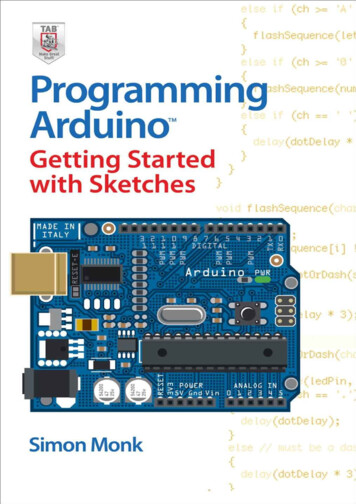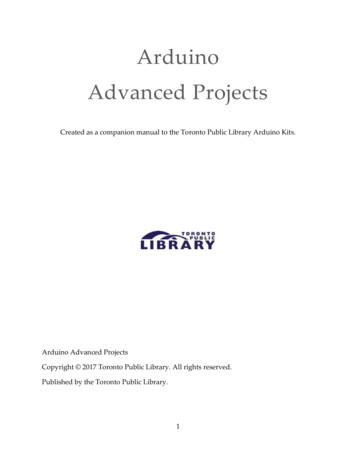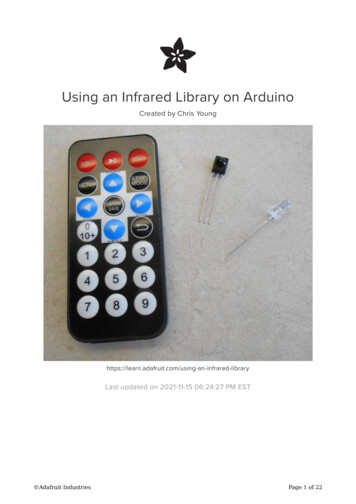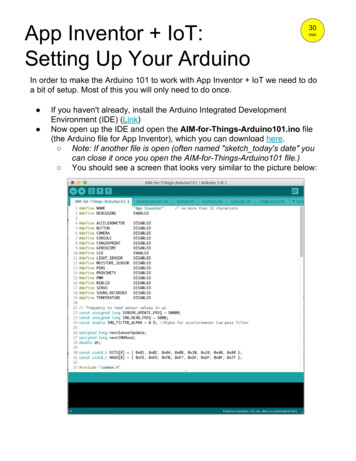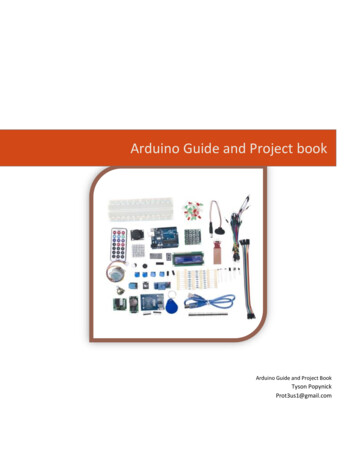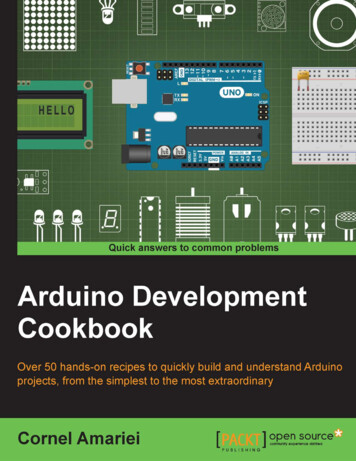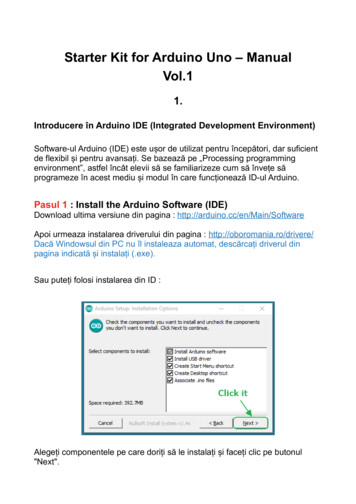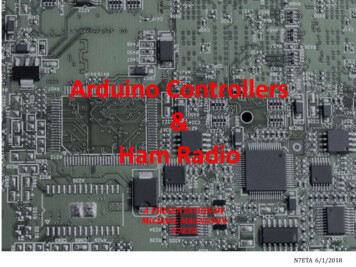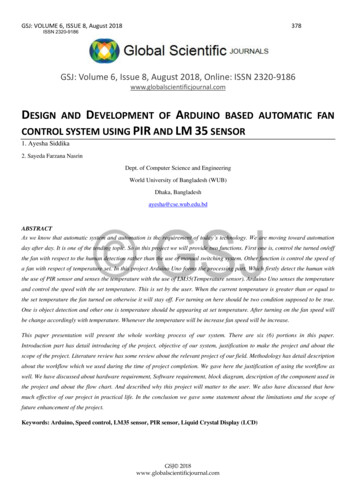
Transcription
GSJ: VOLUME 6, ISSUE 8, August 2018378ISSN 2320-9186GSJ: Volume 6, Issue 8, August 2018, Online: ISSN LOPMENT OF ARDUINO BASEDCONTROL SYSTEM USING PIR AND LM 35 SENSORANDAUTOMATIC FAN1. Ayesha Siddika2. Sayeda Farzana NasrinDept. of Computer Science and EngineeringWorld University of Bangladesh (WUB)Dhaka, Bangladeshayesha@cse.wub.edu.bdABSTRACTAs we know that automatic system and automation is the requirement of today’s technology. We are moving toward automationday after day. It is one of the tending topic. So in this project we will provide two functions. First one is, control the turned on/offthe fan with respect to the human detection rather than the use of manual switching system. Other function is control the speed ofa fan with respect of temperature set. In this project Arduino Uno forms the processing part. Which firstly detect the human withthe use of PIR sensor and senses the temperature with the use of LM35(Temperature sensor). Arduino Uno senses the temperatureand control the speed with the set temperature. This is set by the user. When the current temperature is greater than or equal tothe set temperature the fan turned on otherwise it will stay off. For turning on here should be two condition supposed to be true.One is object detection and other one is temperature should be appearing at set temperature. After turning on the fan speed willbe change accordingly with temperature. Whenever the temperature will be increase fan speed will be increase.This paper presentation will present the whole working process of our system. There are six (6) portions in this paper.Introduction part has detail introducing of the project, objective of our system, justification to make the project and about thescope of the project. Literature review has some review about the relevant project of our field. Methodology has detail descriptionabout the workflow which we used during the time of project completion. We gave here the justification of using the workflow aswell. We have discussed about hardware requirement, Software requirement, block diagram, description of the component used inthe project and about the flow chart. And described why this project will matter to the user. We also have discussed that howmuch effective of our project in practical life. In the conclusion we gave some statement about the limitations and the scope offuture enhancement of the project.Keywords: Arduino, Speed control, LM35 sensor, PIR sensor, Liquid Crystal Display (LCD)GSJ 2018www.globalscientificjournal.com
GSJ: VOLUME 6, ISSUE 8, August 2018379ISSN 2320-9186i. IntroductionIn our country especially in rooms switching on or off electrical fans is still commonly made by manual switches Hence, peopleare becoming so busy that they forgot to turn off switches after leaving the room. The world temperature is increasing rapidly so anew technology is required to adapt to this varying temperature The need for automatic system is the concern of today’stechnology.There are two functions in this system. Switching on and off control according to human detection and Speed control of the fanaccording to temperature. Fan speed will be changed automatically according to temperature using LM35 and fan will be turnedon when the temperature will appear to 270 C and when human will enter the room. Fan will be turned off when human will leavethe room. Temperature and speed information will be displayed in a LED screen. Temperature sensor (LM35) will senses theroom temperature. The speed of the fan is controlled by using PWM technique according to the room temperature. PIR sensorsused to detect the people who are entering or leaving in the room .PIR sensors allow to sense motion, almost always used to detectwhether a human has moved in or out of the room.ii. Related Literature SurveyPower Consumption Rate of BangladeshThe U.S. Energy Information Administration provides data for Bangladesh from 1980 to 2014. The average value for electricityconsumption of Bangladesh during that period was 15.1 billion kilowatt-hours with a minimum of 1.8 billion kilowatthours in1980 and a maximum of 46.17 billion kilowatthours in 2014. [1]Fig 1: Graphical view of power consumption rate of BangladeshReview of Relevant projectsThere are some abstractions of publications which are relevant to our proposed system. According to those publications we haveincluded the information about existing system. The existing system has scope of upgrade. And existing system has somelimitations. We have gathered lot of information from the literature and have discussed here. The information we have gatheredwhich are about Automatic control fan using various electronic component and Arduiono as well. We have got additionalknowledge from particular publication about human sensing device. We have gathered knowledge about our proposed systemfrom some article as well which has been published by an organization.2.2.1 Discussion about Automatic speed control fan using various componentsWe gathered some knowledge from some publications regarding our project. We have discussed here the main principal of thoserelevant projects.Automatic Temperature Controlled Fan Using ThermistorIn this paper for sensing the temperature Thermistor has been used. Here also described that how the speed of a fan can becontrolled, based on temperature sensor. A sensor is a type of transducer. In a broader sense, a transducer is sometimes defined asany device that converts energy from one form to another. Besides that, the component that made up the temperature sensor isknown as Thermistor. Thermistor is a kind of temperature dependent resistor and its resistance varies depending on thetemperature in its vicinity.it can also be used to control the room temperature, depending on the property of ThermistorGSJ 2018www.globalscientificjournal.com
GSJ: VOLUME 6, ISSUE 8, August 2018380ISSN 2320-9186Fig 2: Circuit diagram of Automatic temperature controlled fan using ThermistorIntelligent Temperature Monitor and PWM Fan ControllerTexas Instruments Incorporated (TI) has been published an article about Intelligent. Temperature Monitor and PWM FanController: In this system for the monitoring of temperature the AMC6821 has been used. It is designed for noise-sensitive orpower-sensitive applications that require active system cooling. Using either a low-frequency or a high-frequency PWM signalThe AMC6821 has three fan control modes: Auto Temperature-Fan mode Software-RPM mode And Software-DCY modeEach mode controls the fan speed by changing the duty cycle of a PWM output. Auto Temperature-Fan mode is an intelligent,closed-loop control that optimizes fan speed according to user-defined parameters. This mode allows the AMC6821 to run as astand-alone device. the AMC6821 adjusts the PWM output to maintain a consistent fan speed at a user-specified target value thatis, the device functions as a fan speed regulator. Software-RPM mode can also be usedto allow the AMC6821 to operate as a stand-alone device. [6]Fig .3: Functional block diagram of Intelligent Temperature Monitor and PWM Fan ControllerAutomatic fan speed control system using ArduinoAccording to this paper they used the following algorithm to control the speed of a fan according to temperature. For sensing thetemperature LM 35 has been used. The program of the Arduiono is done by C language.[7]AlgorithmSet T 0,fan Speed 0 and led off2. T get Temp() // Get current temperature from temperature sensor(i.e., LM 35)3. Now compare the value of T with range of temperatures and set the fan Speed according to thata) if T 25C and T 300 Cfan Speed 25%GSJ 2018www.globalscientificjournal.com
GSJ: VOLUME 6, ISSUE 8, August 2018381ISSN 2320-9186b) if T 30C and T 400 Cfan Speed 50%c) if T 40C and T 450 Cfan Speed 75%d) if T 450 Cfan Speed 100%led On4. EndFig 4: Connection Relay with Arduino Fig 2.5: Connection LCD and LM35 with ArduinoAutomatic Fan Speed Control System Using MicrocontrollerPIC16F877A Microcontroller has been used for the main controlling system. LM35 sensor has been used for sensing temperature.Which can decode written instructions and convert them to electrical signals? The microcontroller will then step through theseinstructions and execute them one by one. As an example of this a microcontroller could be used to control the fan speedaccording to the temperature of the room. Microcontroller has been used instead of hard wiring a number of logic gates together toperform some function use instructions to wire the gates electronically. The list of these instructions given to the microcontrolleris called a program.[3]GSJ 2018www.globalscientificjournal.com
GSJ: VOLUME 6, ISSUE 8, August 2018382ISSN 2320-9186Fig 5 : Circuit diagram of automatic speed control fan using microcontroller 7Speed control of fan based on room temperature by using programmable logic Controller (PLC)The design of speed control of fans based on room temperature using PLC technique. This design can be expand in terms ofpower at layout and being characterized level by advanced VLSI application. The system is done by the P.L.C software RS Logix500 that are installed, in this software program is installed based on temperature by connected temperature sensor to the input tosense the temperature and a controller to control the speed of fans by their resistance coil or capacitor and fans movingaccordingly. The whole system having consist of three different unit where the first one is PC runs a program called RS Logix 500next one is P.L.C of allen-braddly to control the system and last one is fan or rotating pare that should be moved according to thetemperature. Programming is being done on the allen-bradley P.L.C. the analog input is given to the P.L.C in the not scaledmanner that's why it need to convert in to the scale manner that is possible by changing the format 0 to 4095 resolution. If theinput of the P.L.C is on than it will be converted to 4095 and if it is not on than it will be converted to 0. [9]Following steps are followed for programming as:RUN 1 Press the start the button.RUN 2 temperature sensor sense the temperature.RUN 3 according to the temperature corresponding input will on.RUN 4 fans will start accordingly.RUN 5 if the temperature is less than 26 degree fans will stop automatically.RUN 6 and heater will startRUN 6 end of the programDesign an Automatic Temperature Control System for Smart Electric Fan Using PICGSJ 2018www.globalscientificjournal.com
GSJ: VOLUME 6, ISSUE 8, August 2018ISSN 2320-9186Fig 6: Circuit diagram of Automatic Temperature Control System for Smart Electric Fan Using PIC8383It is an It has an automation operation by using a microcontroller. It uses a unique design such as 2 fans, 2 LEDs and 2temperature sensors. This is to enhance its functionality to become more efficient and effective for large space and hot weathercondition. the circuit can also detect when fire occurs by alarming the buzzer. All the operations are controlled by the PIC16F876A to produce the output. The PIC is as a brain of the circuit. The LCD, fans and buzzer are the output where they are setwith the pseudo code of PIC. The LCD is used to measure and show the changes of temperature value. The fan starts to functionwhen the switch is turned on. The high value of temperature causes both fan’s to turn on automatically. Then, the buzzer willactive when the temperature reaches an unusual value. [4]Room Temperature based Fan Speed Control System using Pulse Width Modulation TechniqueFig 7: Circuit simulation of Room Temperature based Fan Speed Control System using Pulse Width Modulation TechniqueThis paper presents the design and simulation of the fan speed control system using PWM technique based on the roomtemperature. A temperature sensor has been used to measure the temperature of the room and the speed of the fan is variedaccording to the room temperature using PWM technique. The duty cycle is varied from 0 to 100 to control the fan speeddepending upon the room temperature, which is displayed on Liquid Crystal Display. Pulse WidthModulation (PWM) is atechnique in which the width of the periodic sequence pulses is varied in accordance with the baseband signal. PWM is alsoknown as Pulse Duration Modulation. The leading edge of the pulse is held constant and the change in pulse width with signal ismeasured with respect to leading edge. In PWM, the pulse width is proportional to the amplitude of the signal. By varying theduty cycle of the pulse, the speed of the fan can be controlled. Duty cycle may be defined as the amount of time in a particularperiod during which the pulse is active or high. The speed is made slow, medium, fast, very fast and zero by having different dutycycles. [5]2.3 Discussion about Human tracking electronic device Using sensor A Human Tracking Fan SystemThe student of ECE department of CORNELL University, New York constructed a smart fan in which is controlled by PIR sensorwith human tracking. The project consists of Two dual element PIR sensors directed in the same direction as the fan. The PIRsensors measure infra-red light that is radiated in their field of view. They each contain two internal compensating Pyro electricwindows, one positive and the other negative, to minimize disruption from sources. Such as temperature variation. The speed ofexecution was satisfactory for the most part. Upon detection of a human the sensing circuit responds immediately, causing thecircuit output to go high. This low to high transition is captured by the microcontroller and system operation begins.Unfortunately,once the sensor does detect a human, its output may remain level for as much as 2.5 seconds. The system cannot respond until thesensor output settles since a rising edge is required to trigger a new response from the system. There are two solution imposed forthis problem in multiple ways, but these changes resulted in the degradation of the circuit’s sensing distance and sensitivity. Tosolve the problem included increasing the comparator’s voltage threshold as well as decreasing the integrator’s feedbackresistance to quickly discharge the capacitor. Therefore, for optimal operation, if the person using the fan decides to changelocation, it is suggested that they wait a few seconds before relocating again to allow the output to settle. One rotation isapproximately 19 seconds. This is sufficient to lag a little behind a person's walking pace. The fan stops once it reaches its correctdestination. The fan usually stops directly or nearly in front of the person, as desired. In addition, the sensing distance is quitegood and can be up to 3 meters. The field of view for the sensors used, D203B PIR, is shown in Figure 4. Since 10 we coveredhalf the sensor’s window to increase the sensor’s sensitivity we also halved its field of view. Thus, motion outside this field ofview will most likely not be detected. Although the sensors almost always detect humans, other sources of heat, especially in thelab, will occasionally trigger the sensors as well. The main sources are electrical equipment in the lab closely situated by theGSJ 2018www.globalscientificjournal.com
GSJ: VOLUME 6, ISSUE 8, August 2018384ISSN 2320-9186PIR sensors. The fan usually stops directly or nearly in front of the person, as desired. In addition, the sensing distance is quitegood and can be up to 3 meters. The field of view for the sensors used, D203B PIR Since we covered half the sensor’s window toincrease the sensor’s sensitivity we also halved its field of view. Thus, motion outside this field of view will most likely not bedetected. Although the sensors almost always detect humans, other sources of heat, especially in the lab, will occasionally triggerthe sensors as well. The main sources are electrical equipment in the lab closely situated by the PIR sensors.2.4.2 Smart Surveillance System Using PIR Sensor Network and GSMInternational Journal of Advanced Research in Computer Engineering & Technology (IJARCET) has been published a paper inJanuary 2015 about Smart Surveillance System Using PIR Sensor Network and GSM. This security system is based on theembedded system along with GSM and sensor networks. The human movement is detected using the PIR sensors. In this time, thesystem triggers an alarm detecting the presence of person in a specific interval of time and simultaneously sends the how manypersons are intruder via message to the SMS through GSM Modem. When the security system is activated, the CCTV camera isactivated. This highly reactive approach has low computational requirement. Therefore it is well suited for home surveillancesystem. This surveillance security system implemented using PIC micro controller, camera, GSM and sensors. Surveillance is afield of security system which is used to monitoring of the behavior, activities, or other changing information, usually of peoplefor the purpose of influencing, managing, directing, or protecting them. It is used home, office, factory or vehicle monitoring andimage identification, but this system requires a high performance core, which works against some advantages of embeddedsystems, such as low power consumption and low cost.iii. Proposed systemBlock diagram of the proposed SystemPower SupplyInputOutputFanTemperaturesensorARDUINOLCDPIR sensorFig. 8: Block diagram of the proposed systemGSJ 2018www.globalscientificjournal.com
GSJ: VOLUME 6, ISSUE 8, August 2018385ISSN 2320-9186Circuit diagram of the proposed systemFig.9: Circuit diagram of proposed systemiv. Necessary ComponentsArduino UNOFig 10: Arduino UNOThe Arduino Uno is a microcontroller board based on the ATmega328 (datasheet). It has 14 digital input/output pins (of which 6can be used as PWM outputs), 6 analog inputs, a 16 MHz ceramic resonator, a USB connection, a power jack, an ICSP header,and a reset button. It contains everything needed to support the microcontroller; simply connect it to a computer with a USB cableor power it with a AC-to-DC adapter or battery to get started.GSJ 2018www.globalscientificjournal.com
GSJ: VOLUME 6, ISSUE 8, August 2018386ISSN 2320-9186LM35 (Temperature Sensor)Fig 11:LM35 (Temperature Sensor)LM35 is a precision IC temperature sensor with its output proportional to the temperature (in oC). The sensor circuitry is sealedand therefore it is not subjected to oxidation and other processes. With LM35, temperature can be measured more accurately thanwith a thermistor. It also possess low self-heating and does not cause more than 0.1 oC temperature rise in still air.The operatingtemperature range is from -55 C to 150 C. The output voltage varies by 10mV in response to every oC rise/fall in ambienttemperature, i.e., its scale factor is 0.01V/ oC.PIR(Human Sensor)Fig 12: PIR(Human Sensor)(Passive InfraRed sensor) A device used to detect motion by receiving infrared radiation. When a person walks past the sensor, itdetects a rapid change of infrared energy and sends a signal. PIR sensors are used for applications such as automatically turningon lights when someone enters a room or causing a video camera to begin operating. This passive method is not as reliable asactive motion sensors that either bounce back a radar signal or transmit light to a photo detector in the distance. It’s range up to 10meters at an angle of 15 degrees.Motor 1.5 volt-6.7 voltFig 13: Motor 1.5 volt-6.7 voltIt is machine, especially one powered by electricity or internal combustion that supplies motive power for a vehicle or for someother device with moving parts.GSJ 2018www.globalscientificjournal.com
GSJ: VOLUME 6, ISSUE 8, August 2018387ISSN 2320-9186Resistor(1K,10K)Fig 14: Resistor (1K,10K)A resistor is an electrical component that limits or regulates the flow of electrical current in an electronic circuit. Resistors canalso be used to provide a specific voltage for an active device such as a transistor.1U F,1000UF, 2200UF capacitorFig 15: 1U F,1000UF, 2200UF capacitorA capacitor is a two-terminal, electrical component. Along with resistors and inductors, they are one of the mostfundamental passive components we use. You would have to look very hard to find a circuit which didn’t have a capacitor in it.What makes capacitors special is their ability to store energy2N2222 TransistorFig 16: 2N2222 TransistorA transistor is a device that regulates current or voltage flow and acts as a switch or gate for electronic signals. Transistors consistof three layers of a semiconductor material, each capable of carrying a current.1N 4007 DiodeFig 17: 1N 4007 DiodeA diode is a specialized electronic component with two electrodes called the anode and the cathode. Most diodes are madewith semiconductor materials such as silicon, germanium, or selenium. Some diodes are comprised of metal electrodes in achamber evacuated or filled with a pure elemental gas at low pressure.GSJ 2018www.globalscientificjournal.com
GSJ: VOLUME 6, ISSUE 8, August 2018388ISSN 2320-9186LCD 16*2Fig 18: LCD 16*2LCD (Liquid Crystal Display) screen is an electronic display module and find a wide range of applications. A 16x2 LCD displayis very basic module and is very commonly used in various devices and circuits. . The data is the ASCII value of the character tobe displayed on the LCD.AdaptorFig 19: AdaptorIt is a connector for joining parts or devices having different sizes, designs, etc., enabling them to be fitted or to work together.BreadboardFig 20: BreadboardA breadboard is a widely used tool to design and test circuit. You do not need to solder wires and components to make a circuitwhile using a bread board. It is easier to mount components & reuse them. Since, components are not soldered you can changeyour circuit design at any point withoutGSJ 2018www.globalscientificjournal.com
GSJ: VOLUME 6, ISSUE 8, August 2018389ISSN 2320-9186v. ConclusionThis paper elaborates the design and construction of fan speed control system to control the room temperature and turned on/offcontrol automatically with the human detection. The temperature sensor was carefully chosen to gauge the room temperature, andmotion sensor was chosen for detect the human Besides, the microcontroller had been used to control the fan speed using the fanspeed in rpm and the Arduino was successfully programmed using C/C Language to compare temperature with standardtemperature and set fan speed and their values displayed on LCD. Moreover, the fan speed will increase automatically if thetemperature room is increased. As conclusion, the system which designed in this work was perform very well, for any temperaturechange and can be classified as automatic control.vi. LimitationArduino Uno is the heart of the circuit. If controller is damaged the whole system will be interrupt.vii. Future worksIn the future, simulating this system there are several improvements can be made in order to upgrade the features such as--1. Using a wireless technology to interface sensor and microcontroller, monitor and control the temperature via internet.2. When temperature exceeds the limit a call will be dialed to the given number by an automatic dialed system.3. With this circuit, an alarm circuit can be added and used effectively in large equipment’s where the risk of being overheated andexplosions are the serious problems, in various industries.REFERENCES[1] (Human-Detecting Fan Only Sends Breeze To People) https://www.psfk.com/2014/05/humansensing-fan.html JosephFridlander, Emmeline Park , A Human Tracking Fan System Cornell University.[2] S. Verma, A. Das, S. Dey, P. Chowdhury, Automatic Temperature Controlled Fan Using Thermistor,ISSN:2321-1156International Journal of Innovative Research in Technology & Science(IJIRTS) July 2016.[3] M. Saad, H. Abdoalgader, and M. Mohamed , Automatic Fan Speed Control System Using Microcontroller, 6th Int'lConference on Electrical, Electronics & Civil Engineering (ICEECE'2014) Nov. 27-28, 2014 Cape Town (South Africa)[4] Z. I. Rizman, K. Ho Yeap, N. Ismail, Design an Automatic Temperature Control System for Smart Electric Fan Using PIC,International Journal of Science and Research (IJSR), India Online ISSN: 2319-7064 Volume 2 ,Issue 9,September 2013[5] V. Bhatia, G. Bhatia, Room Temperature based Fan Speed Control System using Pulse Width Modulation Technique,International Journal of Computer Applications (0975 – 8887) Volume 81 – No5, November2013[6]Intelligent Temperature Monitor and PWM Fan Controller, Texas Instruments http://www.ti.com/sc/docs/stdterms.htm[7] K. Singh, M. Dhar, P. Roy, Automatic fan speed control system using Arduino, ISSN: 2456-4184 International Journal ofNovel Research and Development(IJNRD)4 April 2017[8] M. Sathishkumar,S.Rajini,Smart Surveillance System Using PIR Sensor Network and GSM,International Journal of AdvancedResearch in Computer Engineering & Technology (IJARCET)Volume 4 Issue 1, January 4760/FinalProjects/s2011/esp57 jmf293/esp57 jmf293/index.html.html[9] V. Vats and U. Kumar, Speed control of fan based on room temperature by using programmable logic controller , InternationalJournal of Recent Scientific Research Vol. 6. Issue,4, pp.3537-3539, April, 2015,GSJ 2018www.globalscientificjournal.com
It is one of the tending topic. So in this project we will provide two functions. First one is, control the turned on/off the fan with respect to the human detection rather than the use of manual switching system. Other function is control the speed of a fan with respect of temperature set. In this




